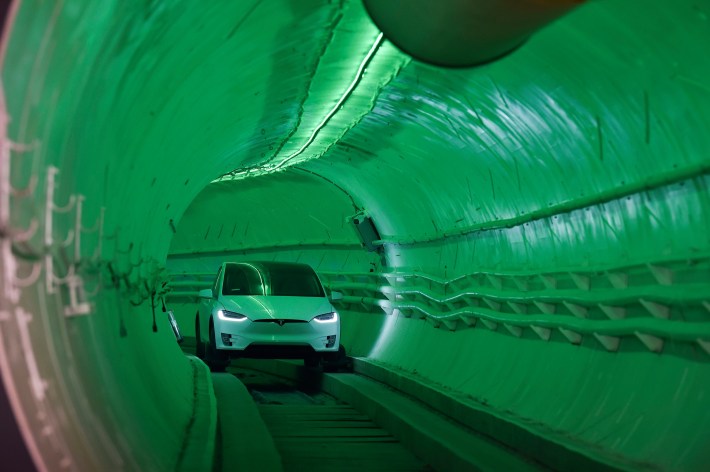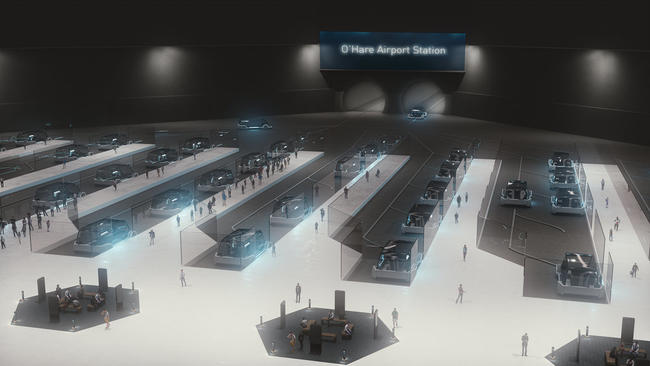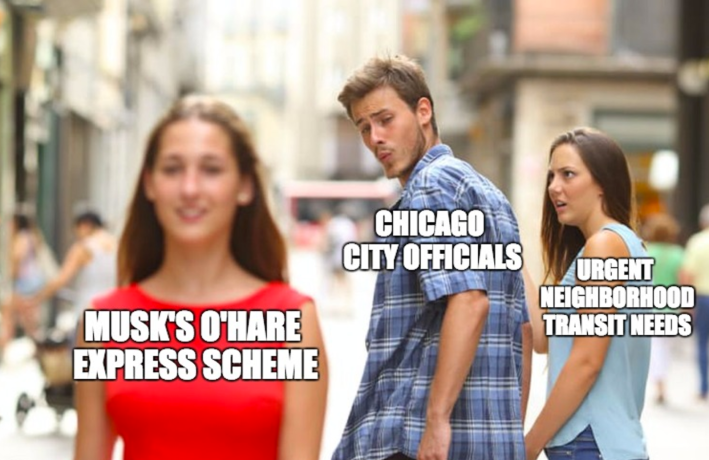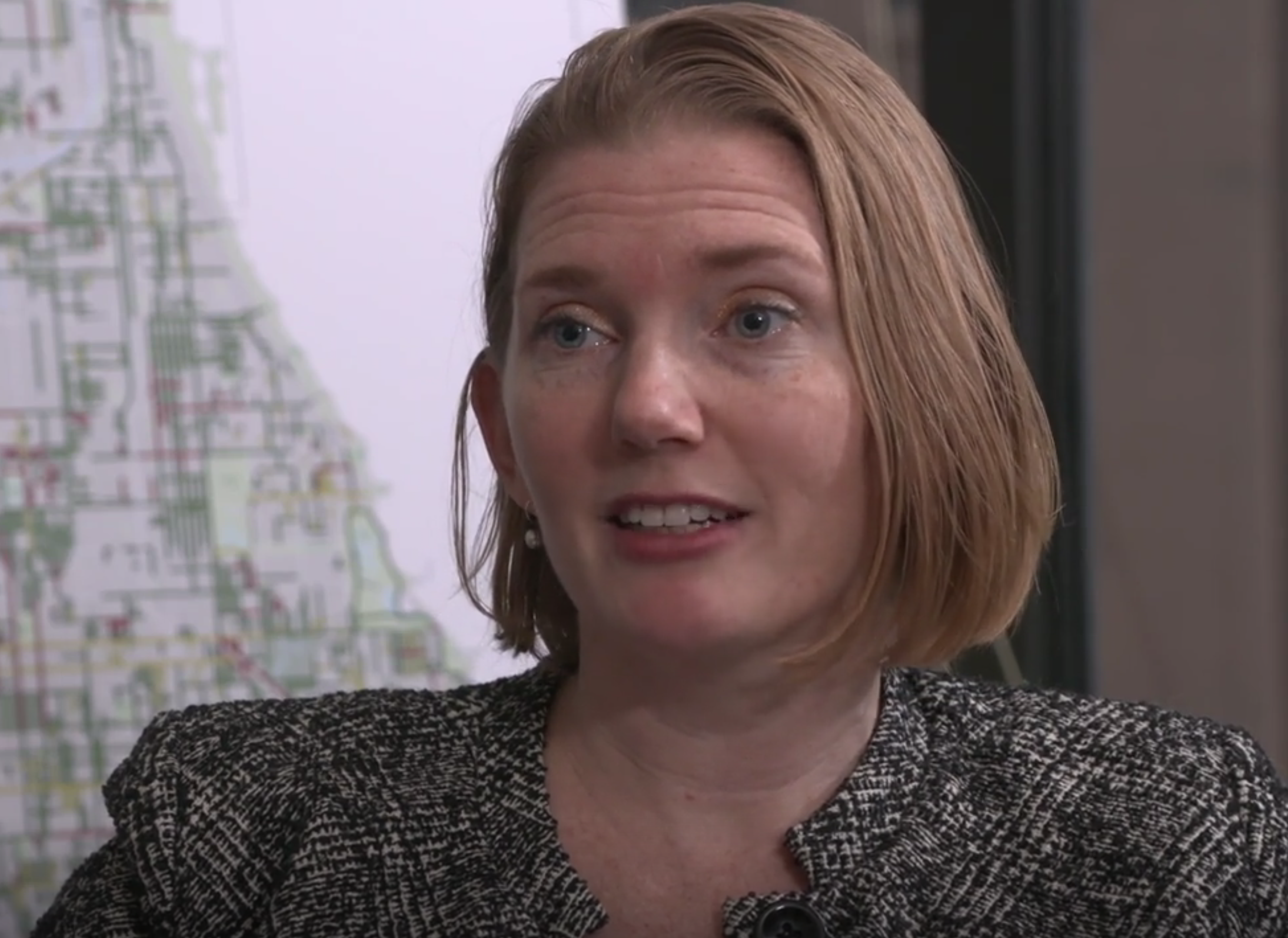Chicago Department of Transportation commissioner Rebekah Scheinfeld has overseen the completion of several good projects during her four years on the job, including the Loop Link bus rapid transit corridor, the Bloomingdale Trail, the Chicago Riverwalk, and 100 miles of new and upgraded bike lanes. (However, it’s worth noting all of these initiatives were launched by her higher-profile predecessor, Gabe Klein.)
Since Scheinfeld’s boss Mayor Rahm Emanuel isn’t running for reelection, it’s likely her tenure will end in a few months. So it’s a head-scratcher why the commissioner recently gave a full-throated endorsement of tech guru Elon Musk’s proposal to dig a tunnel from the Chicago Loop to O’Hare Airport and whisk travelers there at 125-150 mph in 8-16-person pods using “electric skate” technology. Actual transit experts have almost universally dismissed Musk’s plan as a fantasy based on nonexistent tech.
Last week Musk held a press event to unveil a new 6,000-foot-long, 12-foot-wide tunnel in Hawthorn, California, in which attendees were taken on bumpy rides in a Tesla Model X through the passageway. In the wake of the demo, Scheinfeld gave an interview to the Chicago Sun-Times’ Fran Spielman in which she expressed full confidence in the O’Hare Express proposal. Moreover, she urged local alderman to promptly approve the project’s contract for fear of missing out on a once-in-a-lifetime opportunity. Let’s take a closer look at some of Scheinfeld’s key statements from the interview.

On the California presser: “It was a great example of a step forward. As [Chicago deputy mayor Bob] Rivkin said, this isn’t radical new technology, it’s a Tesla in a tunnel. It’s a very basic thing that all Chicagoans can understand and be excited about… [It was] showing proof of concept, essentially.”
What exactly is the step forward here? Musk has previously claimed that his Boring Company’s proprietary digging technology would speed up the digging process 14-fold compared to conventional methods and cut costs by up to 90 percent. But for this tunnel he simply purchased a pre-owned tunneling machine, previously used for digging sewers in Oakland, California, and renamed it “Godot.”
Musk claimed that the 1.14-mile project cost $10 million per mile to build, boasting that this was exponentially cheaper than other tunnels of similar lengths. (It's worth noting that his track record for truthfulness is not the greatest.) Some media outlets have compared the new tunnel to subway projects that cost hundreds of millions per mile.
But other folks have pointed out that, even if Musk’s $10 million figure is accurate, that isn't necessarily impressive since the passageway is a fraction of the width of a subway tunnel, only allows travel in one direction, and has no stations or emergency exits. Moreover, the $10 million number reportedly excludes research, design, and equipment, and may not include the cost of labor and property acquisition.
So, yes, Scheinfeld is correct that this isn’t radical new technology, and it’s a very basic thing that’s easy to understand. But what exactly about driving a car though a small tunnel are Chicagoans supposed to get exited about?
Spielman asked Scheinfeld if there’s actually a market for $25 rides to get to the airport a few minutes faster. “I think there’s a huge market of people who are paying much more than that to get frustrated sitting in traffic in a vehicle on the Kennedy Expressway because of the congestion on the Kennedy,” the commissioner responded.
Musk has claimed that, using his hypothetical technology (the LA event was supposed to feature “autonomous electric skates” carrying 16-20 people, but so far Musk has yet to produce such a pod) he can reduce the transit trip from O’Hare from the current 40-45 minutes on the CTA Blue Line to only 12 minutes. When you’re talking about nonexistent tech, you can pretty much make up whatever time estimates you like but, sure, a theoretical 12-minute, $25 ride would likely attract many well-heeled travelers to make the switch from taxi, ride-share, or livery service.
But it’s still worth noting that, unlike the Blue Line, which makes multiple stops between O’Hare and the Loop, including several stations on Dearborn Street within walking distance of Michigan Avenue hotels, the O’Hare Express would pretty much be a one-trick pony. Once you’re dropped off at the single downtown station at Block 37, you’d likely need to catch a taxi, Uber, or the CTA to your final destination, which would add to the cost and duration of your trip, reducing the convenience.

Spielman asked whether the O’Hare express project would make financial sense for Chicago taxpayers. “It would be totally at the risk of the Boring Company,” Scheinfeld replied. “It’s not too often when you have a private partner coming forward offering to make a major, upwards of a billion-dollar infrastructure investment that could have a real catalytic effect on our economy.”
In reality, the project would cost Chicago taxpayers money, potentially quite a lot of it. The project has already diverted significant city staff time and attention from more pressing neighborhood transportation needs. Former Chicago Aviation chief Ginger Evans previously stated that public money would likely be used for building the stations. And then there’s the cautionary tale of Toronto’s Union Pearson Express airport service, which saw dismal ridership until fares were slashed, which is requiring a public subsidy of $8 U.S. per ride, likely adding up to tens of millions of dollars per year in taxpayer funds.

The reporter asked if it wouldn’t make sense to wait until Chicago’s next mayor takes office before moving forward with the O’Hare express contract. “Our task…is to hammer out this deal,” Scheinfeld said. “This is an example of a project that’s been called for decades. Mayor Daley tried several times to take a cut at this. It was never successful.”
Yeah, you could say that. Daley’s last effort resulted in the $250 million unfinished O’Hare express station below Block 37, which has been a white elephant for the last decade.
Scheinfeld emphasized that it’s going to be necessary for aldermen to strike while the iron is hot by approving the (not-yet-finalized) contract swiftly. “We are very close here. That’s what we have to keep in mind. We have a great opportunity. We would not like to see this go to waste. Ultimately, this is going to be up for approval of City Council and I hope they don’t let it sit idle and risk that that partner would walk away if it’s not approved in a timely manner.”
Spielman then asked whether Scheinfeld truly believed there’s a danger that “the mercurial Mr. Musk” might walk away from the negotiating table.
“Mercurial” is correct, although “dangerously erratic” might be more apt. Here’s just a partial list of loose-cannon behavior by Musk in 2018 alone, which he called the most “excruciating and painful” year of his career.
- Smoking pot on a comedy podcast, which drew a rebuke from NASA
- Attacking the media on Twitter and threatening to create a journalism truth-rating website
- Selling $3.5 million worth of flamethrowers on the Internet
- Committing securities fraud by tweeting about taking Tesla private, which cost him $20 million and Tesla $20 million in a U.S. Securities and Exchange Commission lawsuit settlement, and caused him to be removed as board chair of the company
- Baselessly tweeting that one of the Thai cave rescuers is a pedophile, resulting in an ongoing defamation lawsuit

“I can’t speak for him,” Scheinfeld responded.
That was probably the wisest thing the commissioner said during the entire interview.
The reporter asked how Scheinfeld would respond to the naysayers who say that Musk’s plan involves unproven technology. “I would go back and say it’s a Tesla in a tunnel,” the commissioner responded. “We build tunnels all over the world on a regular basis.”
No, Musk’s O’Hare express proposal does not involve driving cars in tunnels. It calls for using autonomous “electric skate” pods that don’t exist.
Watching the interview, it really is puzzling why Commissioner Scheinfeld opted to compromise her legacy by shilling for a scheme that is most likely snake oil.
![]()
Did you appreciate this post? Consider making a donation through our PublicGood site.




